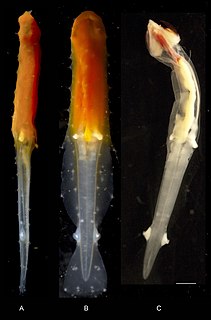Related Research Articles

The Chaetognatha or chaetognaths are a phylum of predatory marine worms that are a major component of plankton worldwide. Commonly known as arrow worms, about 20% of the known Chaetognatha species are benthic, and can attach to algae and rocks. They are found in all marine waters, from surface tropical waters and shallow tide pools to the deep sea and polar regions. Most chaetognaths are transparent and are torpedo shaped, but some deep-sea species are orange. They range in size from 2 to 120 millimetres.
Eukrohniidae is a family of sagittoideans in the order Phragmophora. It consists of a single genus, Eukrohnia von Ritter-Záhony, 1909.
Arganasaurus is an extinct genus of prehistoric temnospondyl amphibian belonging to the family Metoposauridae that lived in Morocco during the Late Triassic (Carnian).

Theodore Wells Pietsch III is an American systematist and evolutionary biologist especially known for his studies of anglerfishes. Pietsch has described 72 species and 14 genera of fishes and published numerous scientific papers focusing on the relationships, evolutionary history, and functional morphology of teleosts, particularly deep-sea taxa. For this body of work, Pietsch was awarded the Robert H. Gibbs Jr. Memorial Award in Systematic Ichthyology by the American Society of Ichthyologists and Herpetologists in 2005. Pietsch has spent most of his career at the University of Washington in Seattle as a professor mentoring graduate students, teaching ichthyology to undergraduates, and curating the ichthyology collections of the UW Burke Museum of Natural History and Culture.
Bouchetia vaubanensis is a species of sea snail, a marine gastropod mollusk in the family Muricidae, the murex snails or rock snails.

Eugène Boullet full name Eugène Anatole Auguste Victor Boullet was a French naturalist, entomologist and collector.
Curnon granulosa is a species of sea slug, a metarminid nudibranch, a marine gastropod mollusc in the family Curnonidae.
Proclavarctus fragilis is a species of tardigrades. It is the only species in the genus Proclavarctus, part of the family Halechiniscidae. The species has been found in deep sea in the Mozambique Channel and the Bay of Biscay.
Exoclavarctus is a genus of tardigrades in the family Halechiniscidae. Its only species is Exoclavarctus dineti. The species has been found in the deep sea in the Bay of Biscay.
Bathycreadium is a genus of trematodes in the family Opecoelidae.

Heterokrohniidae is a family of sagittoideans in the order Phragmophora.
Spadellidae is a family of sagittoideans in the order Phragmophora. Spadellidae prey on plankton and commonly reside in the epipelagic zone of the ocean.
Pseudorhabdosynochus bocquetae is a diplectanid monogenean parasitic on the gills of groupers. It has been described in 1984 by Guy Oliver and Ilan Paperna. The species was first described as Cycloplectanum bocquetae and transferred to the genus Pseudorhabdosynochus by Delane C. Kritsky and Mary Beverley-Burton in 1986.

Archeterokrohnia is a genus of chaetognaths in the family Heterokrohniidae.The total body length excluding tail fin 28.5; the tail section is 55.2% of the tail fin; head blunt when hooded, triangular after preservation, head with 3.5 mm. Furthermore, the eyes are absent, the trunk section is orange throughout in life, and the organism exists around 3200 m below sea level.
Heterokrohnia is a genus of chaetognaths in the family Heterokrohniidae.
Hemispadella is a genus of chaetognaths in the family Spadellidae. It consists of one species, Hemispadella dauvini Casanova, 1996. The species, as the generic name implies, shares numerous, but not all, of the characteristics of Spadellidae; it shares a number of other characteristics with Heterokrohniidae. The ventral ganglion, poorly described in chaetognaths, is of similar size to the Heterokrohniidae, and the larger number of teeth, and the difference in appearance and function between the anterior and posterior teeth, are similarly characteristic. The relative tail size is similar to that of the Spadellidae, although the overall size is unprecedented among the Spadellidae. The more developed nature of transverse musculature and the basis for the lateral fins are as those of Spadellidae, as well.
Paraspadella is a genus of chaetognaths in the family Spadellidae. Paraspadella was originally considered as Spadella before a revision separated that genus into three genera: Spadella, Paraspadella, and Gephyrospadella, the last of which is now synonymised to Paraspadella. The initial division was based on previous knowledge of three groups of Spadella, in a similar manner in which Sagitta was divided into a family of genera. Paraspadella is differentiated from Spadella by the presence of disparate (digital) adhesive organs, present in the former to various degrees, but entirely absent in the latter.

Narindasaurus is a genus of turiasaurian sauropod dinosaur from the Middle Jurassic Isalo III Formation of Madagascar. The type species, N. thevenini was formally described by Royo-Torres et al. in 2020. The holotype, which consists of one specimen, is currently stored at the Muséum national d’Histoire naturelle and has been since 1906 or 1907.

Gaillea is a genus of sea snails, marine gastropod mollusks in the family Buccinidae.
References
- 1 2 3 Casanova, J. (1993). A new genus and species of deep-sea chaetognath from the Bay of Biscay with a strange ventral secretory gland. Journal of Natural History, 27(2), 445–455.
- ↑ Casanova, J. (1987). Deux chaetognathes benthiques nouveaux du genre Spadella des parages de Gibraltar. Remarques phylogénétiques. Bulletin du Muséum national d’Histoire Naturelle, Paris, (4)9A(2), 375–390.
- ↑ Casanova, J. (1986). Archeterokrohnia rubra n. gen., n. sp., nouveau Chaetognathe abyssal de l’Atlantique nord-Africain: description et position systématique, hypothèse phylogénétique. Bulletin du Muséum National d’Histoire Naturelle, Paris, (4)8(A), 185–194.
| | This Chaetognatha-related article is a stub. You can help Wikipedia by expanding it. |